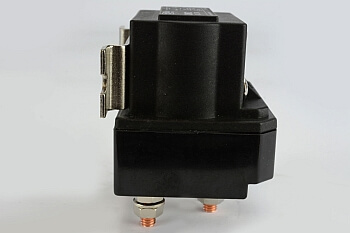

Note: The Red dot in the animation indicated the flow of current path. This change in oscillations will be detected and generates an output either High or Low, nothing but object found or not. whenever there is any metal object nearby to the sensors, the oscillations may vary and it depends on the object properties. The LC Resonant oscillator generates a designed resonant oscillations continuously. Note: The sensor circuit may contain a LC Resonant oscillator or a mutual induction based circuit.

When the object is moved away from sensor circuit, the sensor output is OFF so transistor is OFF and the output will be OFF. When a signal received from the sensor circuit, the transistor will be turned ON and the output will be ON.
#24 VOLT PHOTO SENSE RELAY SWITCH DRIVER#
The transistor based driver circuit may use NPN or PNP transistors and it depends on the application we use. The sensor circuit sends an output High signal to the transistor based driver circuit when any object found near to the sensor circuit. The sensor circuit purpose is used to detect any near by objects. Proximity Switch consists a sensor circuit and a driver circuit. In both examples, the load being driven by each proximity switch is a light-emitting diode (LED): Principle of Operation: The following schematic diagrams contrast the two modes of switch operation, using red arrows to show the direction of current (conventional flow notation). The terms “sourcing” and “sinking” are best understood by visualizing electric current in the direction of conventional flow rather than electron flow.

Instead, their output elements are transistors configured either to source current or sink current. Many proximity switches, though, do not provide “dry contact” outputs. The schematic diagram symbol for a proximity switch with mechanical contacts is the same as for a mechanical limit switch, except the switch symbol is enclosed by a diamond shape, indicating a powered (active) device: Ultrasonic proximity switches sense the presence of dense matter by the reflection of sound waves. Optical proximity switches detect the interruption of a light beam by an object. Capacitive proximity switches sense the presence of non-metallic objects through the use of a high-frequency electric field. Inductive proximity switches sense the presence of metallic objects through the use of a high-frequency magnetic field. That is, they incorporate a powered electronic circuit to sense the proximity of an object. Most proximity switches are active in design. By definition, these switches are non-contact sensors, using magnetic, electric, or optical means to sense the proximity of objects.Ī proximity switch will be in its “normal” status when it is distant from any detectable object.īeing non-contact in nature, proximity switches are often used instead of direct-contact limit switches for the same purpose of detecting the position of a machine part, with the advantage of never wearing out over time due to repeated physical contact. By this way the load connected through the relay contacts can be switched ON and OFF according to the light falling on the photo diode.A proximity switch is one detecting the proximity (closeness) of some object.

A photo relay or light activated relay is a circuit which opens and closes the relay contacts according to the light.Here a photo diode is used to sense the light.The photo diode offers a high resistance when there is no light falling on it.Here the photo diode is connected in reverse biased condition.The only current flowing through it will be due to the minority carriers.When light falls on it, the current due to the minority carriers increase and the diode offers a low resistance.As a result the voltage across the diode will not be sufficient to make the transistor Q1 forward biased and the relay will OFF.When there is darkness the photo diode resistance increases and the voltage across it will become enough to forward bias the transistor Q1 making the relay ON.The diode D2 is used as a freewheeling diode to protect the transistor from transients produced to the switching of relay.


 0 kommentar(er)
0 kommentar(er)
